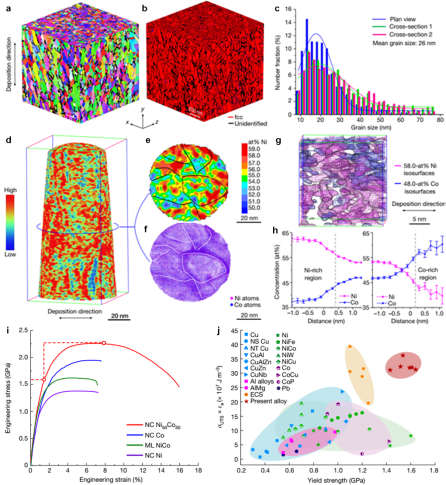Important progress on ultra-strong and ductile nanostructured alloys by Professor Jianshe Lian's research team from Jilin University
Recently, the research team of Professor Jianshe Lian from the School of Materials Science and Engineering of Jilin University cooperated with other research teams and made important progress in developing ultra-strong and ductile nanostructured alloys. The relevant research results, titled "Uniting tensile ductility with ultrahigh strength via composition undulation", were published online on April 13, 2022 in Nature. Jilin University is the first unit to complete this research.
When the grain size within metals is reduced to the nanometer scale, the strength will be greatly improved according to the Hall-Petch relationship. However, when the nanocrystalline metal is plastically deformed, it becomes extremely difficult for dislocations to remain inside such tiny grains, which leads to the loss of strain hardening ability of the material. As a result, the plastic deformation in nanocrystalline metals and alloys tend to be localized and thus become unstable. The trade-off between strength and ductility has become a bottleneck problem restricting the development of the high-performance materials reinforced with nanostructures. Aiming at this key scientific issue, Associate Professor Han Shuang from Professor Jianshe Lian's team, cooperated with Academician Jun Sun, Professor XIangdong Ding, and Professor En Ma of the State Key Laboratory of Metal Material Strength of Xi'an Jiaotong University, Professor Xiaozhou Liao of the University of Sydney and Professor Gang Sha of Nanjing University of Science and Technology, proposed a new mechanism for the strain hardening of ultra-high-strength nano-metals, and designed novel high-performance alloys based on this path.
Using NiCo alloy as a model material, the research team utilized pulse electrodeposition technology to construct a nanocrystalline microstructure (grain size 26 nm) with multi-scale composition fluctuations (1-10 nm) in a face-centered cubic single-phase concentrated solution. The intentionally exacerbated compositional fluctuations contribute to the obvious fluctuations of the stacking fault energy and the lattice strain field, which occur at a spatial scale that can effectively interact with dislocations, thereby changing the dislocation dynamics and making the dislocation motion appear characteristics of hysteresis, intermittent, and entanglement. On the one hand, this promotes the effective storage of dislocations inside the nano-grains, improving the strain hardening ability of the material; on the other hand, it improves the strain rate sensitivity of dislocation movement and improves the strain rate hardening ability. Under the synergetic effect of strain hardening and strain rate hardening, the nano-alloy exhibits a unique optimal combination of strength and ductility at ultra-high flow stress levels, reaching a an unprecedented new height for single-phase face-centered cubic metal (including traditional solvent-solute solid solution): the yield strength of the material reaches 1.6 GPa, the highest tensile strength is close to 2.3 GPa, and the tensile breaking strain can reach 16%.
What is shown in this study is a strengthening mechanism based on the interaction between apparent compositional fluctuations at the nanometer scale (1-10 nm) and mobile dislocations, which is different from the traditional solid-solution strengthening based on differences in atomic radii—that is, interactions between individual solute atoms and dislocations. By selecting a suitable alloy system or preparation process, this concept of structure-composition compound regulation is expected to provide novel paradigm for the design and development of high-performance metallic materials.
Heng Li, a doctoral candidate from the School of Materials Science and Engineering, Jilin University, Professor Hongxiang Zong and Professor Suzhi Li from the State Key Laboratory of Metal Material Strength of Xi'an Jiaotong University are the co-first authors of the paper. Associate Professor Shuang Han, Professor Xiangdong Ding, Professor Gang Sha, Professor Xiaozhou Liao and Professor En Ma En are the co-corresponding authors of the paper. The synchrotron radiation X-ray characterization, testing and analysis involved in the research were completed by a research team led by Professor Ren Yang of the City University of Hong Kong. The research was supported by the Youth Fund Project of the National Natural Science Foundation of China, the Youth Research Fund Project of the Jilin Science and Technology Development Plan, and the National Scholarship Council.
Article link: https://www.nature.com/articles/s41586-022-04459-w

Fig. 1. Composite nanostructure composed of nano-grains (a, b, c) and intragranular multiscale compositional fluctuations (d, e, f) in the Ni50Co50 alloy. Composition fluctuations are distributed in a three-dimensional network (g), and regions of different compositions are separated by "composition boundaries" (h). (i) Tensile engineering stress-strain curves of Ni50Co50 alloy. The tensile curves of nanocrystalline Ni, nanocrystalline Co, and multilayer nanostructured NiCo alloys at the same strain rate are also shown in the figure for reference and comparison. (j) Yield strength-ductility product relationship diagram of nanocrystalline metal materials. The properties of different batches of nanocrystalline Ni50Co50 alloys measured at different strain rates are indicated by red five-pointed stars.